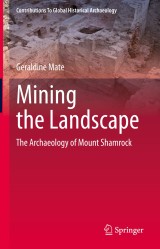Details

Mining the Landscape
The Archaeology of Mount ShamrockContributions To Global Historical Archaeology
|
96,29 € |
|
| Verlag: | Springer |
| Format: | |
| Veröffentl.: | 12.09.2022 |
| ISBN/EAN: | 9783031129063 |
| Sprache: | englisch |
Dieses eBook enthält ein Wasserzeichen.
Beschreibungen
<p>Mining was one of the primary elements of colonial enterprise in Australia and a factor in movement on colonial frontiers. In the second half of the 19th and early 20th century, mining—particularly of gold—saw transformations of the land itself, as well as in the way that people working in mining engaged with the landscape around them. Landscape archaeology provides a theoretical perspective that allows an articulation of how people created and understood the place in which they lived and worked.</p><p><br></p><p>The impact of and narrative surrounding gold mining has meant that it has long been a focus of study, both historical and archaeological. The archaeology of mining has traditionally fallen under the umbrella of industrial archaeology, with analyses based on historical, economic and technological evidence. However this is changing. From an industrial focus, examining the remnants of mines and associated processing equipment, archaeology has progressed towards understandings of the social aspects of mining, recognising that people, not just equipment, occupied these landscapes. Nevertheless, there remains a separation between industrial/technology-based studies and purely social/ household-based archaeological studies—a division that overlooks the integration of home and livelihood.</p><p><br></p><p>This work addresses these very challenges, using a landscape-based approach that articulates a nuanced, meaning-ladened and experienced mining landscape. Integrating the social and the industrial, the case study of Mount Shamrock, a gold-mining town in Queensland, Australia, demonstrates how this methodology can enhance our understanding of the past. </p><p><br></p><p>The work presents an integration of social and industrial perspectives in a mining settlement, and provides an exemplar in the application of landscape theory to Australian historical archaeology. These concepts and approaches, developed in an Australian context, are of universalinterest.</p><div><br></div>
<p>Chapter 1. The landscapes of nineteenth century gold mining.- Chapter 2. Landscapes, places and parts.- Chapter 3. Colonial mining—a global historical context.- Chapter 4. Surveying the past.- Chapter 5. The history of Mount Shamrock.- Chapter 6. The landscape of Mount Shamrock—A ‘settled and business like aspect’.- Chapter 7. Scale, meaning, experience—exploring landscapes.- Chapter 8. The industry of Mount Shamrock—a mine of great promise.- Chapter 9. Towards a social landscape of industry.</p>
Dr Geraldine Mate is the Principal Curator of History, Industry and Technology in the Cultures and Histories Program at Queensland Museum, in Brisbane, Australia. She cares for collections related to industry, science and technology, transport and social history. With degrees in Metallurgical Engineering and Archaeology, and a PhD in Historical Archaeology from the University of Queensland, her current research projects are focused on archaeological investigations of the cultural landscapes of nineteenth and early twentieth century industrial complexes in Australia. Geraldine’s other research interests encapsulate broader reflections on cultural heritage landscapes, the interpretation of industrial cultural heritage and labour history, and the relationship between people and technology. Geraldine has served for several years on the Board of the Qantas Founders Museum, she holds a position on the editorial board of the journal Queensland Archaeological Research and is an editor for theMemoirs of the Queensland Museum – Culture series.
<div><div>Mining was one of the primary elements of colonial enterprise in Australia and a factor in movement on colonial frontiers. In the second half of the 19th and early 20th century, mining—particularly of gold—saw transformations of the land itself, as well as in the way that people working in mining engaged with the landscape around them. Landscape archaeology provides a theoretical perspective that allows an articulation of how people created and understood the place in which they lived and worked.</div><div><br></div><div>The impact of and narrative surrounding gold mining has meant that it has long been a focus of study, both historical and archaeological. The archaeology of mining has traditionally fallen under the umbrella of industrial archaeology, with analyses based on historical, economic and technological evidence. However this is changing. From an industrial focus, examining the remnants of mines and associated processing equipment, archaeology has progressed towards understandings of the social aspects of mining, recognising that people, not just equipment, occupied these landscapes. Nevertheless, there remains a separation between industrial/technology-based studies and purely social/ household-based archaeological studies—a division that overlooks the integration of home and livelihood.</div><div><br></div><div>This work addresses these very challenges, using a landscape-based approach that articulates a nuanced, meaning-ladened and experienced mining landscape. Integrating the social and the industrial, the case study of Mount Shamrock, a gold-mining town in Queensland, Australia, demonstrates how this methodology can enhance our understanding of the past. </div><div><br></div><div>The work presents an integration of social and industrial perspectives in a mining settlement, and provides an exemplar in the application of landscape theory to Australian historical archaeology. These concepts and approaches, developed in an Australian context, are of universal interest.</div></div>
Thought-provoking discussion of theoretical approaches to landscapes Highlight the value of an integration of social and industrial to the field of historical archaeology Integrates highly relevant archaeological and archival data into historical content and discussion chapters

















